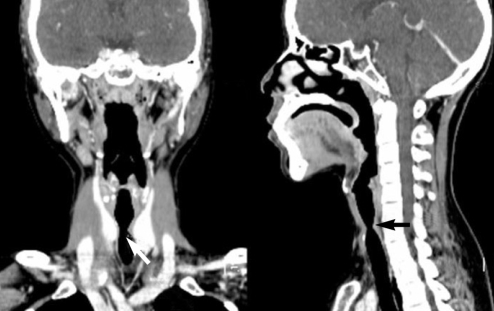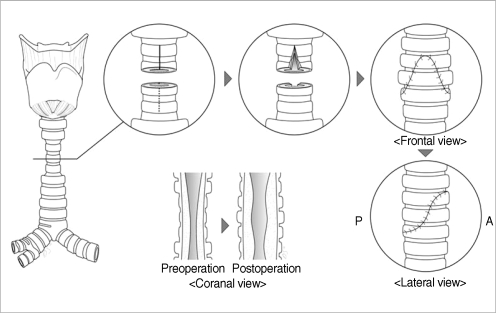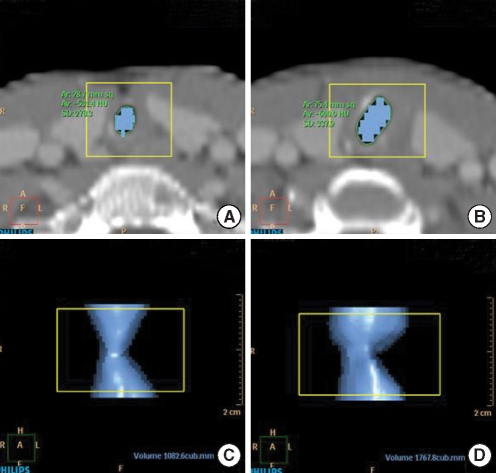Clin Exp Otorhinolaryngol.
2009 Dec;2(4):211-214. 10.3342/ceo.2009.2.4.211.
Successful Treatment of Tracheal Stenosis with Slide Tracheoplasty after the Failure of Resection with End-to-End Anastomosis
- Affiliations
-
- 1Department of Otorhinolaryngology, Gangnam Severance Hospital, Yonsei University College of Medicine, Seoul, Korea. hschoi@yuhs.ac
- 2Department of Radiology, Gangnam Severance Hospital, Yonsei University College of Medicine, Seoul, Korea.
- 3The Institute of Logopedics & Phoniatrics, Gangnam Severance Hospital, Yonsei University College of Medicine, Seoul, Korea.
- KMID: 1466501
- DOI: http://doi.org/10.3342/ceo.2009.2.4.211
Abstract
- The combined effects of inhaled irritant gases and heat in burn patients can result in the development of laryngotracheal strictures. Several factors could adversely affect the development of tracheal stenosis and cause the growth of granulation tissue. Yet the current treatment options for this condition are limited because of the paucity of case reports. We report here on a case of a patient who experienced recurrent upper tracheal stenosis after an inhalation injury. She displayed repetitive symptoms of stenosis even after several laryngomicrosurgeries and resection with end-to-end anastomosis. Finally, 5 yr after the burn injury, slide tracheoplasty was successfully performed and the postoperative check-up findings and the increased airway volume seen on imaging were all satisfactory.
Keyword
MeSH Terms
Figure
Reference
-
1. Gaissert HA, Lofgren RH, Grillo HC. Upper airway compromise after inhalation injury: complex strictures of the larynx and trachea and their management. Ann Surg. 1993; 11. 218(5):672–678. PMID: 8239783.
Article2. Abdelkafy WM, El Atriby MN, Iskandar NM, Mattox DE, Mansour KA. Slide tracheoplasty applied to acquired subglottic and upper tracheal stenosis: an experimental study in a canine model. Arch Otolaryngol Head Neck Surg. 2007; 4. 133(4):327–330. PMID: 17438245.3. Rutter MJ, Cotton RT, Azizkhan RG, Manning PB. Slide tracheoplasty for the management of complete tracheal rings. J Pediatr Surg. 2003; 6. 38(6):928–934. PMID: 12778396.
Article4. Elliott M, Hartley BE, Wallis C, Roebuck D. Slide tracheoplasty. Curr Opin Otolaryngol Head Neck Surg. 2008; 2. 16(1):75–82. PMID: 18197027.
Article5. Endo S, Saito N, Murayama F, Yamaguchi T, Sohara Y. Successful reconstruction of extensive laryngotracheal strictures after inhalation burn injury: report of a case. Surg Today. 2001; 31(12):1070–1073. PMID: 11827185.
Article6. Colice GL. Long-term respiratory complications of inhalation injury. Respiratory injury: smoke inhalation and burns. 1990. New York: McGraw-Hill;p. 336–337.7. Tsugawa J, Satoh S, Nishijima E, Takamizawa S, Muraji T, Kanegawa K, et al. Development of acquired tracheal stenosis in premature infants due to prolonged endotracheal ventilation: etiological considerations and surgical management. Pediatr Surg Int. 2006; 11. 22(11):887–890. PMID: 16932914.
Article8. Schweizer P, Berger S, Petersen M, Kirschner HJ, Schweizer M. Tracheal surgery in children. Eur J Pediatr Surg. 2005; 8. 15(4):236–242. PMID: 16163588.
Article
- Full Text Links
- Actions
-
Cited
- CITED
-
- Close
- Share
- Similar articles
-
- Tracheoplasty for Congenital Tracheal Stenosis: Two case reports
- Repair of Long-segment Congenital Tracheal Stenosis
- Sleeve tracheal resection and end to end anastomosis with suprahyoid release for the circumferential tracheal stenosis
- Result of Tracheal Resection and End-to-end Anastomosis
- Management of tracheal stenosis by tracheal resection and end-to-end anastomosis




